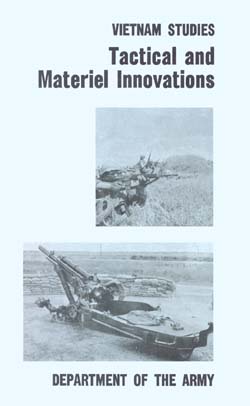
VIETNAM STUDIES
TACTICAL AND MATERIEL INNOVATIONS

by
Lieutenant General John H. Hay, Jr.
DEPARTMENT OF THE ARMY
WASHINGTON, D. C., 1989
These involved helping to fulfill the basic needs of an agrarian population, dealing with the frustrations of antiguerilla operations, and conducting conventional campaigns against well-trained and determined regular units. It is as always necessary for the U .S. Army to continue to prepare for other challenges that lie ahead. While cognizant that history never repeats itself exactly and that no army every profited from trying to meet a new challenge in terms of the old one, the Army nevertheless stands to benefit immensely from a study of its experience, its shortcomings no less than its achievements.
Aware that some years must elapse before the official histories will provide a detailed and objective analysis of the experience in Southeast Asia, we have sought a forum whereby some of the more salient aspects of that experience can be made available now.
At the request of the Chief of Staff, a representative group of senior officers who served in important posts in Vietnam and who still carry a heavy bur den of day today responsibilities has prepared a series of monographs. These studies should be of great value in helping the Army develop future operational concepts while at the same time contributing to the historical record and providing the American public with an interim report on the performance of men and officers who have responded, as others have through our history , to exacting and trying demands .
The qualifications of Lieutenant General
John H. Hay, Jr. , to write Tactical and Materiel Innovations are considerable.
After graduating from the Advanced Management Program at Harvard University,
General Hay served as the Army Member, Military Studies and Liaison Division,
Weapons Systems Evaluation Group, Office of the Secretary of Defense, from
December 1962 to June 1964. General Hay was then assigned as the Commanding
General, Berlin Brigade , in West Berlin, Germany, from July 1964 until August
1966, at which time he became the Commanding General, 11th Infantry Brigade,
U.S. Army, Pacific, September 1966-January 1967. In February 1967 he became
the Commanding General of the 1st Infantry Division in Vietnam and held this
position until March 1968, when he was reassigned as Deputy Commanding General,
II Field Force, Vietnam, responsible for the defense of Saigon. He left Vietnam
in August 1968. On 5 September 1968 he assumed the dual position of Commandant
of the U .S. Army Command and General Staff College, Fort Leavenworth, Kansas,
and Commanding General of the U.S. Army Combat Development Command Institute
of Combined Arm$ and Support. This latter position together with his combat
experience in Vietnam and earlier assignment with the Weapons System Evaluation
Group make General Hay uniquely qualified to be the author of this study.
General Hay is currently the Commanding General of the XVIII Airborne Corps
at Fort Bragg, North Carolina.
| Washington
D.C., 1 May 1973 |
VERNE
L. BOWERS Major General, USA The Adjutant General |
I was the commandant of the U.S. Army Command and General Staff College when General William C. Westmoreland asked me to prepare this monograph. The official archives there, as well as the availability of the college staff, permitted a greater depth of research and analysis than would otherwise have been possible.
We limited our study to innovations which influence the command of an infantry division. My guidance to my assistants was to write for a professional audience, but to make the monograph readable and interesting for the general public. Battle stories are used to illustrate both tactical and materiel innovations.
The study covers only a few of the thousands of innovations which have occurred in Vietnam. However, I think that it serves to define the constant challenge to our soldiers at every level of the Army: to stay ahead of the many changes which are evolving in our profession at this time in our history .
| Washington, D.C. 1 May 1973 | JOHN
H. HAY, JR. Lieutenant General, U.S. Army |
| Chapter | Page |
| I. INTRODUCTION | 3 |
| II. IA DRANG | 10 |
| III. IRVING | 24 |
| IV. LOC NINH | 42 |
| V. REMAGEN AND MONT ANA MAULER | 57 |
| VI. CORONADO X | 66 |
| VII. DAK TO | 78 |
| VIII. FIRE SUPPORT BASE CROOK FIRE SUPPORT SURVEILLANCE BASE FLOYD | 97 |
| IX. TAM KY | 107 |
| X. PHONG CAO | 117 |
| XI. SUOI CAT | 127 |
| XII. LAM SON II | 137 |
| XIII. CU CHI | 148 |
| XIV. VINH LOC AND PHU VANGI | 162 |
| XV. SEARCH AND DESTROY | 169 |
| XVI. SUMMARY | 179 |
| GLOSSARY | 185 |
| 1. Three Phases of Vietnam Strategy | 172 |
| 2. Vietnamese and Allied Forces in South Vietnam | 175 |
| 3. Population Status in South Vietnam | 181 |
| 1. Battles Illustrated | 4 |
| 2. Types of Terrain in South Vietnam | 7 |
Diagrams